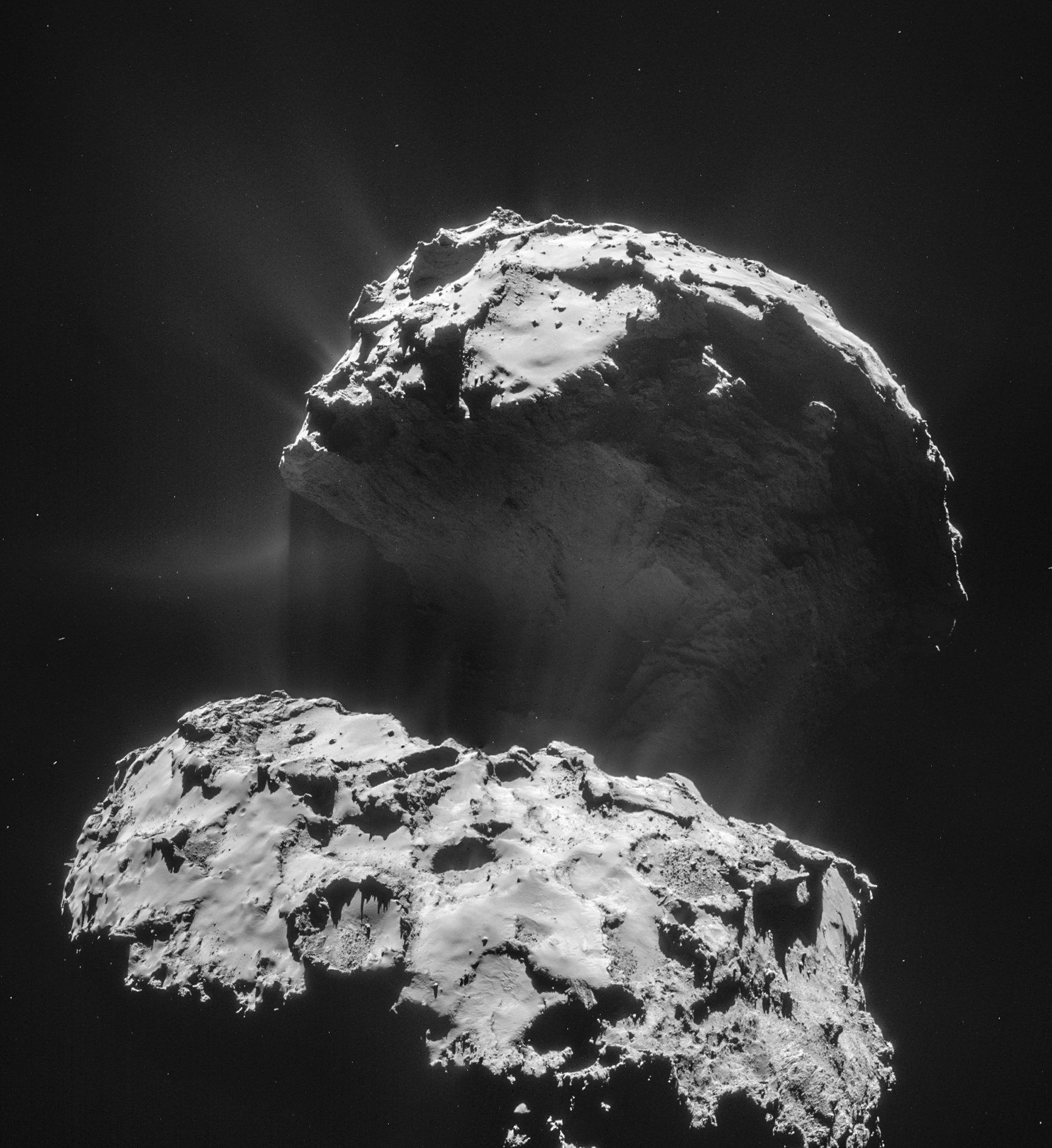
Four image mosaic of Comet 67P/Churyumov-Gerasimenko comprising images taken on 14 February 2015 at 10:15 GMT just prior to closest approach from a distance of 12.6 km from the comet centre (about 10.6 km from the surface). For the comet centre distance, the image scale is 1.1 m/pixel. In this orientation the view is across the ‘back’ of the large comet lobe, with the ‘neck’ and the small comet lobe towards the top of the image. Credits: ESA/Rosetta/NAVCAM/Marco Di Lorenzo/Ken Kremer/kenkremer.com
The Rosetta spacecraft swooped in for a cosmic swoon on Valentine’s Day, Feb. 14, and the close encounter produced stunning high-resolution close-ups and additional observations of the backside, head, and other regions of the comet’s nucleus and coma, which the probe is escorting in a dance around the Sun and studying as it changes over time.
The frigid celestial body is inexorably heating up as it edges ever closer to the Sun, spewing huge quantities of gas and dust as subsurface water ice sublimates, providing an ideal opportunity for gathering samples of the comet’s atmosphere, or coma, for Rosetta’s instruments to analyze and understand how that relates to the observed activity.
Rosetta’s closest approach to Comet 67P/Churyumov–Gerasimenko on Saturday was targeted to pass within about 6 kilometers (3.8 miles) of the bizarre rubber ducky-shaped comet’s pockmarked surface at 12:41 GMT (7:41 EST, 13:41 CET) over the larger of the comet’s two lobes, above the Imhotep region.
“The closest images, taken shortly before and after the point of closest approach respectively, provide stunning details of the contrasting terrains that we have seen so far on the comet,” according to a European Space Agency (ESA) statement.
Among the Valentine’s Day cosmic kiss images taken were four sets of NAVCAM camera images as 2 x 2 rasters. They were downlinked Sunday and have now been released by ESA.

Mission scientists compiled the one NAVCAM image set taken at the closet approach into a mosaic, which is shown above. The remaining three sets have been compiled into mosaics by the image processing team of Marco Di Lorenzo and Ken Kremer and are included herein.
ESA promises that additional comet images taken by the high-resolution OSIRIS science camera will be released in a week or two.
Lighting conditions were near perfect, with the Sun being located directly behind the spacecraft at what is called the “zero phase” angle.
The closest NAVCAM images were taken about 90 minutes after closest approach, at a distance of 8.9 km from the comet’s surface above the Imhotep region on the comet’s larger lower lobe. They reveal a long, layered, and fractured exposed surface that’s visible in the lower left of the mosaic view (above).
Other striking features visible are near-circular objects with smooth floors, as well as several angular blocks that appear to jut out from beneath the surface.
“Boulders, ranging in size from a few meters to a few tens of meters, lie scattered across the whole surface of the comet,” said ESA.
The big boulder known as Cheops is seen at the top center of the mosaic.
About two hours prior to close approach the NAVCAM camera focused intently on the lower lobe of the comet’s backside, looking upward to the head and neck from a distance of about 10.6 km from the heavily fractured and varied surface, revealing few smooth features—see lead photo mosaic.
The comet’s head, or smaller lobe, was targeted by the NAVCAM camera about 8 hours before closest approach at a distance of 35.0 km. It focused on the large depression known as Hatmehit, which is nearby the touchdown point of the Philae landing craft that successfully reached the surface on Nov. 12, 2014, after unexpectedly bouncing three times.

Four image mosaic of Comet 67P/Churyumov-Gerasimenko comprising images taken on 14 February 2015 at 04:32 GMT from a distance of 35.0 km. The image scale is 3.0 m/pixel. The view focuses Hatmehit, the large depression on the comet’s small lobe. Credits: ESA/Rosetta/NAVCAM/Ken Kremer/kenkremer.com/Marco Di Lorenzo
The Valentine’s Day encounter marked Rosetta’s closest flyby of comet 67P ever during the prime mission, and the first dedicated close flyby of the mission.
Researchers used the unique close encounter to target Rosetta to fly over the most active regions of the comet so that scientists can correlate the jets of activity with the composition of the coma and how it evolves and changes at increasing distance from the surface.
Researchers hope to pinpoint the sources of the outflowing gas and dust.
Lengthy cracks in the neck region, named Hapi, and running over 500 meters long have already been detected in prior images, as previously reported here.
Rosetta was programmed to “sniff” and “taste” the comet’s growing coma of gas and dust blasting off from the nucleus of 67P. The body is heating up as it moves ever closer to the warming Sun along its orbital track, causing sublimation of subsurface ices and belching outbursts of gases and dust.

Some seven hours after closest approach, Rosetta took a parting shot looking back at the entire body of 67P from a distance of about 31 km.
Post-flyby the probe was outward bound, and as of today, Feb. 17, Rosetta is collecting data from around 255 km away.
Indeed Saturday’s close encounter starts a new phase for the mission. After completing a phase of bound orbits around the comet on Feb. 4, from a distance of 28 kilometers from the center, Rosetta will now conduct a series of flybys over varying distances during the coming year.

The ESA-led spacecraft first arrived at comet 67P on Aug. 6, 2014, after a decade-long interplanetary chase of some 500 million kilometers (300 million miles) from Earth.
Stay tuned here for continuing developments.
Want to keep up-to-date with all things space? Be sure to “Like” AmericaSpace on Facebook and follow us on Twitter: @AmericaSpace





This might interest you. It explains the varying terrain you see across the whole of Imhotep and how it came about.
https://scute1133site.wordpress.com/2015/01/28/67p-churyumov-gerasimenko-a-single-body-thats-been-stretched-part-13/